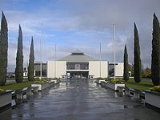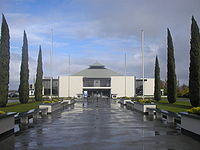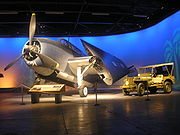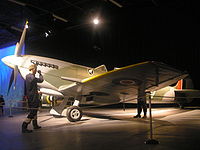
Royal New Zealand Air Force Museum
Encyclopedia
The Royal New Zealand Air Force Museum or Air Force Museum of New Zealand as it is now known, is an air force museum located located at Wigram
, the RNZAF's first operational base, in Christchurch
, in the South Island
of New Zealand. It opened on 1 April 1987, the 50th anniversary of the establishment of the RNZAF, and is primarily a museum of the Royal New Zealand Air Force
, its predecessor, the New Zealand Permanent Air Force and New Zealand squadrons of the Royal Air Force
. The Air Force Museum of New Zealand's mission is to preserve and present the history of New Zealand military aviation for commemoration, learning, inspiration and enjoyment.
The Air Force Museum of New Zealand's mission is to preserve and present the history of New Zealand military aviation for commemoration, learning, inspiration and enjoyment.
The museum holds the national collection of the Royal New Zealand Air Force. The collection includes objects covering the early days of New Zealand military aviation both prior to World War I and during this major conflict, the interwar years which saw the formation of the RNZAF in 1937, New Zealanders who fought in the RAF and in other Allied air forces during World War II, the RNZAF’s campaign in the Pacific, and the post-war period to the present day. The collection also includes objects from former enemy forces, aircraft, aircraft components, aircraft engines, large objects, textiles, art and memorabilia as well as an extensive paper and photographic archive.
After many years of charging admission the Museum has now moved to free admission. Visitors can take a "Restoration Tour" through 'behind the scenes' areas of the Museum including the Restoration and Reserve Collection hangars. The Museum currently has three aircraft restoration projects; the p-40 Curtiss Kittyhawk, the Airspeed Oxford and the Vicker's Vildebeest. The Museum has also has a Mosquito Flight Simulator, which features a mission based on the Allied bombing of German battleships in the Norwegian fiords.





Wigram Aerodrome
Wigram Aerodrome is a former Royal New Zealand Air Force base located in the Christchurch suburb of Wigram. It is named after Sir Henry Wigram. Originally home to the RNZAF Central Flying School , it was decommissioned in 1995 following the CFS' relocation to RNZAF Ohakea two years earlier.Wigram...
, the RNZAF's first operational base, in Christchurch
Christchurch
Christchurch is the largest city in the South Island of New Zealand, and the country's second-largest urban area after Auckland. It lies one third of the way down the South Island's east coast, just north of Banks Peninsula which itself, since 2006, lies within the formal limits of...
, in the South Island
South Island
The South Island is the larger of the two major islands of New Zealand, the other being the more populous North Island. It is bordered to the north by Cook Strait, to the west by the Tasman Sea, to the south and east by the Pacific Ocean...
of New Zealand. It opened on 1 April 1987, the 50th anniversary of the establishment of the RNZAF, and is primarily a museum of the Royal New Zealand Air Force
Royal New Zealand Air Force
The Royal New Zealand Air Force is the air arm of the New Zealand Defence Force...
, its predecessor, the New Zealand Permanent Air Force and New Zealand squadrons of the Royal Air Force
Royal Air Force
The Royal Air Force is the aerial warfare service branch of the British Armed Forces. Formed on 1 April 1918, it is the oldest independent air force in the world...
.

The museum holds the national collection of the Royal New Zealand Air Force. The collection includes objects covering the early days of New Zealand military aviation both prior to World War I and during this major conflict, the interwar years which saw the formation of the RNZAF in 1937, New Zealanders who fought in the RAF and in other Allied air forces during World War II, the RNZAF’s campaign in the Pacific, and the post-war period to the present day. The collection also includes objects from former enemy forces, aircraft, aircraft components, aircraft engines, large objects, textiles, art and memorabilia as well as an extensive paper and photographic archive.
After many years of charging admission the Museum has now moved to free admission. Visitors can take a "Restoration Tour" through 'behind the scenes' areas of the Museum including the Restoration and Reserve Collection hangars. The Museum currently has three aircraft restoration projects; the p-40 Curtiss Kittyhawk, the Airspeed Oxford and the Vicker's Vildebeest. The Museum has also has a Mosquito Flight Simulator, which features a mission based on the Allied bombing of German battleships in the Norwegian fiords.
Aircraft
- Auster Mk 7cAuster AOP.6-Bibliography:*Halley, J.J., The Squadrons of the Royal Air Force & Commonwealth 1918-1988, Air-Britain, Tonbridge, ISBN 0-85130-164-9....
(Antarctic) (Ex-RNZAF, NZ1707, restored)
-
- New Zealand used Austers for army co-operation work in the immediate post-war period. They were fitted with floats and, in this case, skis. This aircraft accompanied the HillaryEdmund HillarySir Edmund Percival Hillary, KG, ONZ, KBE , was a New Zealand mountaineer, explorer and philanthropist. On 29 May 1953 at the age of 33, he and Sherpa mountaineer Tenzing Norgay became the first climbers known to have reached the summit of Mount Everest – see Timeline of climbing Mount Everest...
/Fuchs Trans-Antarctic ExpeditionCommonwealth Trans-Antarctic ExpeditionThe 1955–58 Commonwealth Trans-Antarctic Expedition was a Commonwealth-sponsored expedition that successfully completed the first overland crossing of Antarctica, via the South Pole...
, and has been restored to this configuration.
- New Zealand used Austers for army co-operation work in the immediate post-war period. They were fitted with floats and, in this case, skis. This aircraft accompanied the Hillary

- Avro 626 (Ex-RNZAF, NZ203, restored)
-
- A development of the Avro Tutor biplane trainer featuring a third cockpit with scarf ring, and was designed to enable training of all aircrew positions. This aircraft was restored to flying condition in the 1980s by the RNZAF and flew for a period with the RNZAF Historic Flight but is now permanently preserved in the museum.
- Avro AnsonAvro AnsonThe Avro Anson is a British twin-engine, multi-role aircraft that served with the Royal Air Force, Fleet Air Arm and numerous other air forces prior to, during, and after the Second World War. Named for British Admiral George Anson, it was originally designed for maritime reconnaissance, but was...
(restored, a composite of several aircraft).
-
- Developed as a maritime patrol aircraft New Zealand acquired a small number of Ansons early in World War II for use as navigation trainers, supplementing the Airspeed Oxford. A small number of more advanced model Ansons were used for communications work after the war.
- BAC Strikemaster 167 (Ex-RNZAF, NZ6373).
-
- An armed version of the Jet Provost trainer, itself a jet version of the radial-engine Provost, the Strikemaster, or 'Blunty' was used by the RNZAF as an advanced jet trainer for pilots progressing onto the A4 Skyhawk in the 1970s and 1980s.
- Bell UH-1 IroquoisUH-1 IroquoisThe Bell UH-1 Iroquois is a military helicopter powered by a single, turboshaft engine, with a two-bladed main rotor and tail rotor. The helicopter was developed by Bell Helicopter to meet the United States Army's requirement for a medical evacuation and utility helicopter in 1952, and first flew...
(Ex-US Army, display painted as RNZAF aircraft).
-
- New Zealand acquired UH1Ds in 1965, and subsequently added UH1Hs. New Zealand Iroquois pilots have served in VietnamVietnamVietnam – sometimes spelled Viet Nam , officially the Socialist Republic of Vietnam – is the easternmost country on the Indochina Peninsula in Southeast Asia. It is bordered by China to the north, Laos to the northwest, Cambodia to the southwest, and the South China Sea –...
, the SinaiSinai PeninsulaThe Sinai Peninsula or Sinai is a triangular peninsula in Egypt about in area. It is situated between the Mediterranean Sea to the north, and the Red Sea to the south, and is the only part of Egyptian territory located in Asia as opposed to Africa, effectively serving as a land bridge between two...
, Antarctica and East TimorEast TimorThe Democratic Republic of Timor-Leste, commonly known as East Timor , is a state in Southeast Asia. It comprises the eastern half of the island of Timor, the nearby islands of Atauro and Jaco, and Oecusse, an exclave on the northwestern side of the island, within Indonesian West Timor...
.
- New Zealand acquired UH1Ds in 1965, and subsequently added UH1Hs. New Zealand Iroquois pilots have served in Vietnam
- Bleriot XIBlériot XIThe Blériot XI is the aircraft in which, on 25 July 1909, Louis Blériot made the first flight across the English Channel made in a heavier-than-air aircraft . This achievement is one of the most famous accomplishments of the early years of aviation, and not only won Blériot a lasting place in...
"Britannia" (replica)
-
- New Zealand's first military aircraft the Bleriot arrived in 1913 and was flown in New Zealand for two years before being returned to the United Kingdom in 1915. Replica built by David Comrie of Dunedin.
- Bristol FreighterBristol FreighterThe Bristol Type 170 Freighter was a British twin-engine aircraft designed and built by the Bristol Aeroplane Company as both a freighter and airliner, although its best known use is as an air ferry to carry cars and their passengers over relatively short distances.-Design and development:The...
B170 Mk 31M (Ex-RNZAF, NZ5903).
-
- The Bristol Freighters of the RNZAF were a familiar sight in the New Zealand sky for nearly 26 years. The museum's aircraft was added to the collection after retirement from the RNZAF in early 1978.
- Cessna 0-2A-CE (On loan from USAF Museum)
-
- Display painted to represent aircraft flown by New Zealand pilots on attachment to United States Air Force during Vietnam WarVietnam WarThe Vietnam War was a Cold War-era military conflict that occurred in Vietnam, Laos, and Cambodia from 1 November 1955 to the fall of Saigon on 30 April 1975. This war followed the First Indochina War and was fought between North Vietnam, supported by its communist allies, and the government of...
.
- Display painted to represent aircraft flown by New Zealand pilots on attachment to United States Air Force during Vietnam War
- De Havilland Tiger MothDe Havilland Tiger MothThe de Havilland DH 82 Tiger Moth is a 1930s biplane designed by Geoffrey de Havilland and was operated by the Royal Air Force and others as a primary trainer. The Tiger Moth remained in service with the RAF until replaced by the de Havilland Chipmunk in 1952, when many of the surplus aircraft...
DH82A (Ex-RNZAF, NZ1481, restored).
-
- Manufactured in WellingtonWellingtonWellington is the capital city and third most populous urban area of New Zealand, although it is likely to have surpassed Christchurch due to the exodus following the Canterbury Earthquake. It is at the southwestern tip of the North Island, between Cook Strait and the Rimutaka Range...
at RongotaiRongotaiThis article discusses the Wellington city suburb of Rongotai. For the article about the New Zealand parliamentary electorate of the same name see Rongotai ...
, the Tiger Moth was the RNZAF's primary trainer throughout World War II. The aircraft is display painted as NZ825.
- Manufactured in Wellington
- De Havilland VampireDe Havilland VampireThe de Havilland DH.100 Vampire was a British jet-engine fighter commissioned by the Royal Air Force during the Second World War. Following the Gloster Meteor, it was the second jet fighter to enter service with the RAF. Although it arrived too late to see combat during the war, the Vampire served...
DH100 FB5 & DH115 T11 (restored).
-
- New Zealand's first jet fighter procured in numbers, the Vampire was first used by the RNZAF in CyprusCyprusCyprus , officially the Republic of Cyprus , is a Eurasian island country, member of the European Union, in the Eastern Mediterranean, east of Greece, south of Turkey, west of Syria and north of Egypt. It is the third largest island in the Mediterranean Sea.The earliest known human activity on the...
in the 1950s. It survived into the early 1970s as a trainer.
- New Zealand's first jet fighter procured in numbers, the Vampire was first used by the RNZAF in Cyprus
- de Havilland Devon DH104 (Ex-RNZAF, NZ1803)
-
- Replacement for the Anson, the Devon is a militarised version of the De Havilland DoveDe Havilland DoveThe de Havilland DH.104 Dove was a British monoplane short-haul airliner from de Havilland, the successor to the biplane de Havilland Dragon Rapide and was one of Britain's most successful post-war civil designs...
, used as a navigation and multi engine trainer. This aircraft was added to the museum's collection after retirement from the RNZAF.
- Replacement for the Anson, the Devon is a militarised version of the De Havilland Dove

- de Havilland Canada DHC-2 BeaverDe Havilland Canada DHC-2 BeaverThe de Havilland Canada DHC-2 Beaver is a single-engined, high-wing, propeller-driven, STOL aircraft developed by de Havilland Canada, primarily known as a bush plane. It is used for cargo and passenger hauling, aerial application , and has been widely adopted by armed forces as a utility aircraft...
(type example display painted as NZ6001)
-
- The original NZ6001 was one of two antarctic aircraft serving on the ice from 1956 and was lost in an accident on the Beardmore Glacier in January 1960.
- Douglas C-47B Dakota(ex-RNZAF, NZ3551)
-
- This aircraft was retired from operational flying in late 1977 and flown to Wigram for display in the museum. NZ3551 is displayed exactly as it left VIP service in 1977.
- English Electric (G.A.F.) Canberra B.20 (type example, ex-RAAF, A84-240)
-
- This aircraft was gifted to the museum by the RAAF in 1984 to be displayed as a type example. A former RNZAF machine donated by the Indian Air Force is in storage awaiting restoration.

- Grumman Avenger TBF-1C (Ex-RNZAF, NZ2504, restored)
-
- Display painted as NZ2521.
- Hawker Siddeley Andover C Mk1 (Ex-RNZAF, NZ7621)
-
- The museum's aircraft is the sole surviving RNZAF example in New Zealand and was added to the collection after retirement.
- Kaman SH-2 SeaspriteSH-2 SeaspriteThe Kaman SH-2 Seasprite is a ship-based helicopter with anti-submarine, anti-surface threat capability, including over-the-horizon targeting. This aircraft extends and increases shipboard sensor and weapon capabilities against several types of enemy threats, including submarines of all types,...
SH-2F (Ex-RNZN, NZ3442)
-
- Donated to the museum by the Kaman Aircraft Corporation, having been written off as beyond economic repair as the result of an accident whilst in service with the Royal New Zealand Navy.

- Lockheed HudsonLockheed HudsonThe Lockheed Hudson was an American-built light bomber and coastal reconnaissance aircraft built initially for the Royal Air Force shortly before the outbreak of the Second World War and primarily operated by the RAF thereafter...
Mk 3 (Ex-RNZAF, NZ2013, restored)
-
- The museum's aircraft underwent major restoration over many years which involved its complete reconstruction. It is displayed in its 1942 colour scheme.
- McDonnell Douglas A-4 SkyhawkA-4 SkyhawkThe Douglas A-4 Skyhawk is a carrier-capable ground-attack aircraft designed for the United States Navy and United States Marine Corps. The delta winged, single-engined Skyhawk was designed and produced by Douglas Aircraft Company, and later McDonnell Douglas. It was originally designated the A4D...
(Three, A4K, TA4K Kahu and an A4C on loan from United States Navy)
-
- The A4K and TA4K are as retired. Prior to their retirement, the A4C was acquired and converted to early RNZAF A4K specification and display painted as NZ6207 an RNZAF aircraft lost in an accident in 1977. As all surviving RNZAF A4s were heavily modified under the Kahu programme in the 1980s the A4C represents the type in its first 15 years of RNZAF use.
- North American Harvard Mk 3 (Ex-RNZAF, NZ1087, restored)
-
- Display painted as NZ948 of No.2 SFTS Woodbourne 1943.
- North American P-51 MustangP-51 MustangThe North American Aviation P-51 Mustang was an American long-range, single-seat fighter and fighter-bomber used during World War II, the Korean War and in several other conflicts...
(type example)
-
- This ex-Indonesian Air Force aircraft was acquired by the museum in 1985 and is display painted to represent NZ2410 of No.4 Squadron Territorial Air Force, Taieri, 1951-55.
- Pacific Aerospace CT-4B Airtrainer (Ex-RNZAF, NZ1948)
-
- This aircraft served as an initial flying trainer from 1978 to 1993. It was transferred to the museum for preservation after retirement.
- Sopwith PupSopwith PupThe Sopwith Pup was a British single seater biplane fighter aircraft built by the Sopwith Aviation Company. It entered service with the Royal Flying Corps and the Royal Naval Air Service in the autumn of 1916. With pleasant flying characteristics and good maneuverability, the aircraft proved very...
(replica)
-
- Built by Skysport Engineering in the United Kingdom as a flying replica. The aircraft suffered a crash landing on its maiden flight in 1985. Acquired by the museum in 1995 and display painted as N6460, the aircraft flown by H F Beamish, a New Zealander serving with the Royal Naval Air Service during WWI.

- Supermarine SpitfireSupermarine SpitfireThe Supermarine Spitfire is a British single-seat fighter aircraft that was used by the Royal Air Force and many other Allied countries throughout the Second World War. The Spitfire continued to be used as a front line fighter and in secondary roles into the 1950s...
LF Mk XVIE (Ex-RAF, TE288, restored)
-
- This aircraft was gifted to the Christchurch Brevet Club in 1963 and for many years stood on a plinth outside their club building. In 1984 the aircraft was replaced with a fibre glass replica and the real aircraft was relocated to the Air Force Museum of New Zealand. The aircraft is display painted as a 485 (NZ) Squadron aircraft. Another Spitfire owned by Brendon Deere is based with the RNZAF historic flight at Ohakea.
- Westland WaspWestland WaspThe Westland Wasp was a British small first-generation, gas-turbine powered, shipboard anti-submarine helicopter. Produced by Westland Helicopters, it came from the same P.531 programme as the British Army Westland Scout, and was based on the earlier piston-engined Saunders-Roe Skeeter...
HAS Mk 1 (Ex-RNZN, NZ3906)
-
- Used by the RNZN from Leander and Anzac frigates. The museum's aircraft was added to the collection after retirement.
Under restoration
- Airspeed OxfordAirspeed OxfordThe Airspeed AS.10 Oxford was a twin-engine aircraft used for training British Commonwealth aircrews in navigation, radio-operating, bombing and gunnery during the Second World War.-Design and development:...
- Curtiss P-40Curtiss P-40The Curtiss P-40 Warhawk was an American single-engine, single-seat, all-metal fighter and ground attack aircraft that first flew in 1938. The P-40 design was a modification of the previous Curtiss P-36 Hawk which reduced development time and enabled a rapid entry into production and operational...
E Kittyhawk (nearing completion) - Vickers VildebeestVickers VildebeestThe Vickers Vildebeest and the similar Vickers Vincent were two very large two- to three-seat single-engined British biplanes designed and built by Vickers and used as a light bomber, torpedo bomber and in the army cooperation roles...

